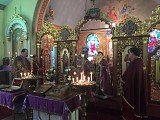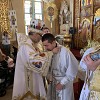UKRAINIAN ORTHODOX CHURCH OF THE USA
CONSISTORY OFFICE OF PUBLIC RELATIONS
PRESS RELEASE
Vladyka Daniel Leads the Prayers of Holy Monday at the Dormition of the Birth-Giver of God Ukrainian Orthodox Parish in Lorain, OH
As the celebration of this year’s Palm Sunday (Entrance of our Lord in Jerusalem) concluded, the sacred time of Holy Week started in parishes of the Ukrainian Orthodox Church of the USA. Full liturgical schedule is carefully offered and crafted for the faithful of the Church so that they may re-live the sacred moments of our Lord’s journey from the gates of Jerusalem to the place of crucifixion and burial.
On Holy Monday (April 25, 2016) the faithful of the Dormition of the Birth-Giver of God Ukrainian Orthodox parish in Lorain, OH celebrated the first day of Holy and Sacred Week with their spiritual father and Ruling Hierarch of the Western Eparchy of the UOC of the USA – His Grace Bishop Daniel.
Assisted by the pastor of the parish’s family – Very Rev. Dmitri Belenki, Very Rev. Fr. John Nakonachny and Very Rev. Fr. Michael Hontaruk of St. Vladimir Ukrainian Orthodox Cathedral in Parma, OH as well as Very Rev. Fr. Dennis Kristof of St. Nicholas Ukrainian Orthodox Pro-Cathedral in Lakewood, OH and Very Rev. Fr. Roman Yatskiv of St. Nicholas Ukrainian Orthodox parish in Monessen, PA – Vladyka Daniel led the celebration of the Liturgy of Presanctified Gifts. Following the chanting of Gospel reading, His Grace shared a reflection with those in attendance, stressing upon the importance of the observance of Holy Week and its meaning in the life of an Orthodox Christian.
These three days, which the Church calls Great and Holy have within the liturgical development of the Holy Week a very definite purpose. They place all its celebrations in the perspective of End; they remind us of the eschatological meaning of Pascha. So often Holy Week is considered one of the “beautiful traditions” or “customs,” a self-evident “part” of our calendar. We take it for granted and enjoy it as a cherished annual event which we have “observed” since childhood, we admire the beauty of its services, the pageantry of its rites and, last but not least, we like the fuss about the paschal table. And then, when all this is done we resume our normal life. But do we understand that when the world rejected its Savior, when “Jesus began to be sorrowful and very heavy... and his soul was exceedingly sorrowful even unto death,” when He died on the Cross, “normal life” came to its end and is no longer possible. For there were “normal” men who shouted “Crucify Him” who spat at Him and nailed Him to the Cross. And they hated and killed Him precisely because He was troubling their normal life. It was indeed a perfectly “normal” world which preferred darkness and death to light and life.... By the death of Jesus the “normal” world, and “normal” life were irrevocably condemned. Or rather they revealed their true and abnormal inability to receive the Light, the terrible power of evil in them. “Now is the Judgment of this world” (John 12:31). The Pascha of Jesus signified its end to “this world” and it has been at its end since then. This end can last for hundreds of centuries this does not alter the nature of time in which we live as the “last time.” “The fashion of this world passeth away...” (I Cor. 7:31).
Pascha means Passover, passage. The feast of Passover was for the Jews the annual commemoration of their whole history as salvation, and of salvation as passage from the slavery of Egypt into freedom, from exile into the promised land. It was also the anticipation of the ultimate passage—into the Kingdom of God. And Christ was the fulfillment of Pascha. He performed the ultimate passage: from death into life, from this “old world” into the new world into the new time of the Kingdom. And he opened the possibility of this passage to us. Living in “this world” we can already be “not of this world,” i.e. be free from slavery to death and sin, partakers of the “world to come.” But for this we must also perform our own passage, we must condemn the old Adam in us, we must put on Christ in the baptismal death and have our true life hidden in God with Christ, in the “world to come....”
And thus Pascha (Easter) is not an annual commemoration, solemn and beautiful, of a past event. It is this Event itself shown, given to us, as always efficient, always revealing our world, our time, our life as being at their end, and announcing the Beginning of the new life.... And the function of the three first days of Holy Week is precisely to challenge us with this ultimate meaning of Pascha and to prepare us to the understanding and acceptance of it.
During the liturgical service, a set of special petitions for the living victims of Chornobyl Nuclear Disaster was offered, calling upon those in attendance to remember the lost and the living of the Nuclear Tragedy that took place exactly 30 years ago (26 April, 1986).
Moreover, at the very end of the service, the faithful of the parish family were treated to the presence of the icon of the Venerable Fathers of the Monastery of Kyiv Caves (16th century) and twelve relics of various saints of the same monastery. Approaching the relics and venerating the icon, every person in attendance received a blessing from their bishop as well united with the venerable Fathers of the Monastery of Caves, who by their life and example of Faith journeyed towards spiritual perfection, yet calling upon us all to follow their example.
Holy Monday in Lorain, OH - 04/25/2016
Photos by Seminarian Mykola Zomchak
(16 images)
|
| |||||||||||||

































